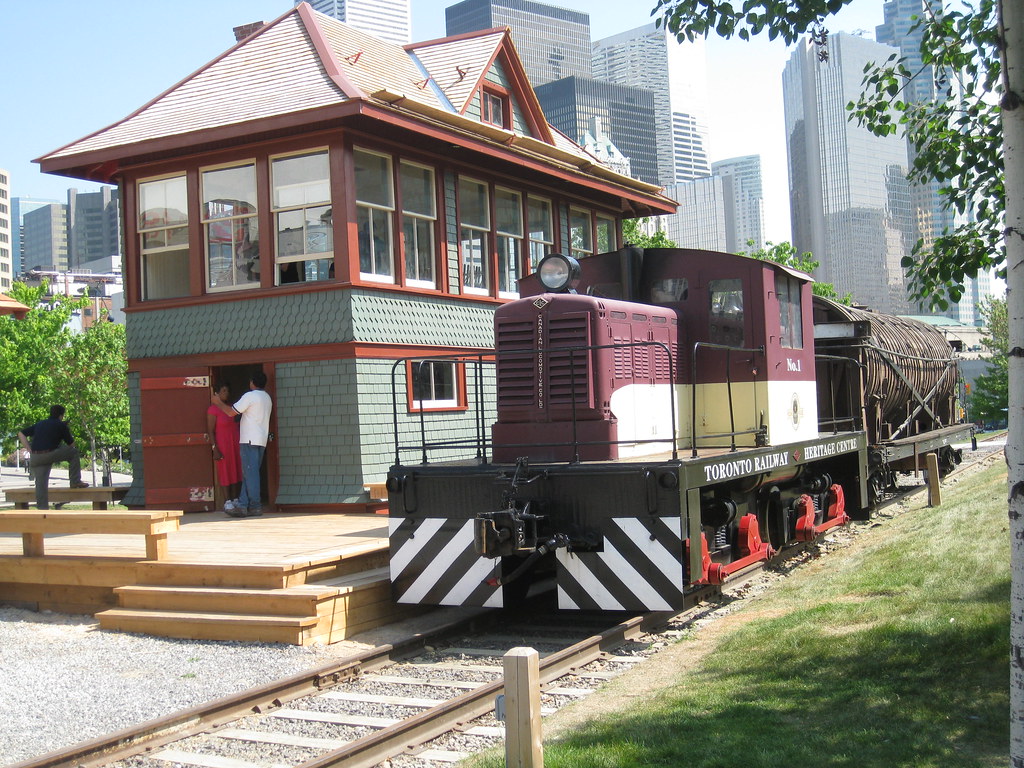Just in time for Doors Open this weekend, the John Street Roundhouse Park National Railway and Heritage Centre staged its grand opening today. The 17-acre park includes four full-sized locomotives dating back to 1944 as well as Toronto’s own car, No. 1, built in Kingston, Ontario in 1950. (Hurry, though, if you want to see it; the roundhouse will soon be fenced off as part of the security buildup to the G20.)
There are also three freight cars and two passenger cars in the park. The roundhouse has been cleaned up and bays 15, 16, and 17 have been set up by the Toronto Railway Historical Association as a simulation of what it’s like to drive a real diesel train. Visitors are able to board the cab of an Electromotive Division F7, as well as the General Electric U33C Diesel Cab and use actual controls to drive through a scene depicting mid-1950s downtown Toronto.
Another interactive component of the Heritage Centre is the Roundhouse Park Miniature Railway. A fully operational miniature train can carry up to 24 people around the park. After Mayor David Miller drove the train for a photo op, the conductor had to fix a minor derailment caused by merely reversing the train without enough weight on it.
The most impressive aspects to the park are the completely restored railway village buildings, which were given a historical designation in 1990. The Don Station, Cabin D, a watchman’s shanty and tool shed have been cleaned up and restored as best as possible to their original condition. The Don Station’s insides are completely original, which is obvious by the peeling paint and tiny door frames. The cedar shingle skirting and the upturned roof on Cabin D were restored to reflect the appreciation for Asian pagodas that was revered in the nineteenth century.
Cabin D was actually located at the Bathurst Street junction until it was retired in 1983 after an increase in GO transit traffic required newer technology than that of the manual switches. The original sign is hung above a window in the building, which houses the switch tenders.
While there are still finishing touches to be done on the buildings, the entire project owes its existence to 60 volunteers who donated 20,000 hours of their time to restore and rebuild the historical railway system over the last nine years. “This is an example of Toronto volunteerism at its absolute finest, which vastly understates the contribution of the TRHA,” said Miller.
The achingly long progress of the transformation can be followed on the Toronto Railway Heritage Association’s website, http://www.trha.ca/





4 comments
Okay. I want to visit this place the next I visit Toronto!
Montreal was the birthplace and heart of Canada’s rail system from day one, until only a few decades ago. We even have a huge railway museum.
Toronto = “National Railway Heritage Centre?”
Montreal’s Exporail = “The Canadian Railway Museum.”
I believe the post was in error. The correct name is the Toronto Railway Heritage Centre, not National.
I, too, found it strange that a “National Railway Heritage Centre” would be found in Toronto rather than Montreal (still a major railway hub and headquarters for CN) or Calgary (who owes a good part of its existence to the railroad and is home to CPR).
Sounds like a nice spot, though, and why not. The more railway museums, the better!